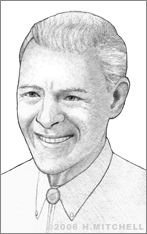Robert Gundlach
The everyday actions of any office worker undoubtedly involve making a photocopy. Though we take this seemingly simple, yet extremely helpful, time-saving operation for granted, only through the ingenious work and perseverance of people like Robert W. Gundlach are we able to so carelessly rely on the technology.
Gundlach, born on Sept. 7, 1926, earned a BA in Physics from the University of Buffalo in his native New York State in 1949. He pursued graduate studies until 1951, when he joined Surez Plastics and Chemicals. The following year, he was hired by the Haloid Company, which, in 1944, had acquired rights to Chester Carlson’s electrophotography technology. The company would later become Haloid Xerox, Inc., and finally, in 1961, Xerox Corp.
At the time Gundlach joined the firm, he was just 26 years old, and there were just under a hundred people working on a new process called “xerography” for making copies. The technology was just beginning to gain some acceptance in the business world, but the copies that the machines were capable of producing were crude, and the equipment was slow, expensive, and cumbersome.
As one of the first scientists hired by Haloid, Gundlach, who had the opportunity to work with and become well acquainted with Chester Carlson, was charged with improving xerography machines and making them smaller, faster, and more affordable. The work that he did during his first year at Haloid resulted in three patentable inventions, one of which made it possible to create metal masters for offset duplication. He also developed an idea that allowed photocopiers to reproduce solid shapes, rather than simple outlines, which made the idea of making copies more universally acceptable.
The “Xerox Tone Tray” components that he created for this purpose were leased en masse at great profit to Xerox. They first became available in the 1950s.
Gundlach’s most lucrative patent for Xerox, however, was for “tri-level development,” or creating two colored images in a single pass. He and his son, who also worked for Xerox, are said to have come up with the original concept, where a transparent toner would be used to undercoat the areas of a page that would be printed on. Then, the machine would print by inkjet over the coated areas and put the paper through a xerographic fuser to set the image.
A team led by Gundlach designed a complete system that would develop a second color very softly without disturbing or contaminating the first color image. New software was needed to generate the program for the laser, which could write the two sets of images at just the right voltages.
The technology was introduced in 1991 as the 4850 Highlight Color Laser Printing System. It has generated around a billion dollars per year for Xerox since its debut.
Gundlach earned 155 of his more than 164 total patents while working for Xerox. He was named Xerox’s first Research Fellow in 1966 and, in 1978, Senior Research Fellow. His patents cover imaging methods and fusing processes, cleaning methods, optical systems, and charging systems.
Gundlach’s many honors and awards include the 1963 Charles E. Ives Award for “Best Paper of the Year,” the Kosar Memorial Award in 1976, the Johann Gutenberg Prize from the Society for Information Display in 1993, and the Lifetime Achievement Award from the Electrostatics Society of America in 1997. He was elected to the National Academy of Engineering in 1994, and in 1995, he was a recipient of the Xerox Presidents Award for Lifetime Achievement.
Gundlach retired from Xerox in 1995 but continued to work for companies such as Aetas Technology, where he earned his 160th patent on a charging process for full color xerographic imaging; Xerox, where he occasionally served as an expert witness in litigation projects; and as a Research Fellow with Torrey Pines Research of Rochester, New York.
He also worked on his own projects related to energy conservation with an eye on curbing global warming. In this vein, he developed a new high efficiency heat pump system that could help reduce the energy required to heat and cool residential housing in urban areas by over 60 percent. He earned another patent on this machine in 2004. In 2005, Gundlach was inducted into the National Inventors Hall of Fame.
He died on August 18, 2010 from aspiration pneumonia.


